1000+ Cell - the unit of life MCQ for CEED [Solved]
Thursday 9th of March 2023

Sharing is caring
1. Which one of the following structures between two adjacent cells is an effective transport pathway?
A. Plasmodesmata
B. Plastoquinones
C. Endoplasmic reticulum
D. Plasmalemma
Answer : A
A. Plasmodesmata
B. Plastoquinones
C. Endoplasmic reticulum
D. Plasmalemma
Answer : A
2. Active transport differs from passive transport in that active transport
A. requires energy.
B. always requires input of ATP.
C. moves molecules against a concentration gradient.
D. both (a) and (c)
Answer : D
A. requires energy.
B. always requires input of ATP.
C. moves molecules against a concentration gradient.
D. both (a) and (c)
Answer : D
3. Which of the following pair lack the unit membrane?
A. Nucleus and E.R.
B. Mitochondria and chloroplast
C. Ribosome and nucleolus
D. Golgi body and lysosome
Answer : C
A. Nucleus and E.R.
B. Mitochondria and chloroplast
C. Ribosome and nucleolus
D. Golgi body and lysosome
Answer : C
4. The best way to identify a cell as either prokaryotic or eukaryotic is to determine whether
A. it came from a single-celled or multicellular organism.
B. it has a nucleus.
C. it has a plasma membrane.
D. it has cytosol.
Answer : A
A. it came from a single-celled or multicellular organism.
B. it has a nucleus.
C. it has a plasma membrane.
D. it has cytosol.
Answer : A
5. Grana are
A. protein storing plastids.
B. coloured plastids.
C. stacks of thylakoids.
D. individual thylakoids present in stroma.
Answer : C
A. protein storing plastids.
B. coloured plastids.
C. stacks of thylakoids.
D. individual thylakoids present in stroma.
Answer : C
6. 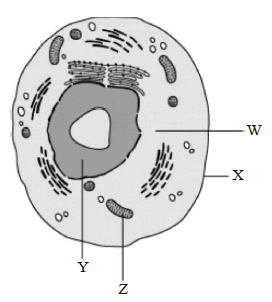
Which function is carried out by the cell organelle 'X'?
A. helps control the movement of substance in and out of the cell
B. passes information from the parent cell to newly formed cell
C. maintains the proper shape of the cell and serves as a protective barrier
D. helps the cell to make food with the help of chlorophyll and sunlight
Answer : A

Which function is carried out by the cell organelle 'X'?
A. helps control the movement of substance in and out of the cell
B. passes information from the parent cell to newly formed cell
C. maintains the proper shape of the cell and serves as a protective barrier
D. helps the cell to make food with the help of chlorophyll and sunlight
Answer : A
7. Statement 1: Centrosomes and centrioles are related to each other.
Statement 2: Centrosome usually contains two cylindrical structures called centrioles.
A. Both statements -1 and statement - 2 are true and statement - 2 is the correct explanation of statement - 1.
B. Both statements -1 and statement - 2 are true but statement - 2 is not the correct explanation of statement - 1.
C. Statement -1 is true and statement - 2 is false.
D. Statement -1 is false and statement - 2 is true.
Answer : A
Statement 2: Centrosome usually contains two cylindrical structures called centrioles.
A. Both statements -1 and statement - 2 are true and statement - 2 is the correct explanation of statement - 1.
B. Both statements -1 and statement - 2 are true but statement - 2 is not the correct explanation of statement - 1.
C. Statement -1 is true and statement - 2 is false.
D. Statement -1 is false and statement - 2 is true.
Answer : A
8. You are asked to examine a cell using a powerful light microscope. The image you see has a clearly defined nucleus and mitochondria. It also has a large central vacuole and chloroplasts. From what group of organisms did this cell most likely come?
A. Bacteria
B. Protists
C. Fungi
D. Plants
Answer : D
A. Bacteria
B. Protists
C. Fungi
D. Plants
Answer : D
9. The lipid component of the membrane mainly consists of __________.
A. polysaccharides
B. phosphoglyceride
C. monosaccharaides
D. both (a) and (c)
Answer : B
A. polysaccharides
B. phosphoglyceride
C. monosaccharaides
D. both (a) and (c)
Answer : B
10. Which one of the following is not considered as part of the endomembrane system?
A. Golgi complex
B. Peroxisome
C. Vacuole
D. Lysosome
Answer : B
A. Golgi complex
B. Peroxisome
C. Vacuole
D. Lysosome
Answer : B
11. Match column I (cell type) with column II (size) and choose the correct option.
A. A I, B II, C III, D IV
B. A IV, B III, C II, D I
C. A I, B III, C II, D IV
D. A IV, B II, C III, D I
Answer : B
| Column-I | Column-II |
|---|---|
| (Cell type) | (Size) |
| A. Viruses | I. 1-2 ??m |
| B. PPLO | II. 10-20 ??m |
| C. Eukaryotic cell | III. About 0.1 ??m |
| D. Bacterium | IV. 0.02 - 0.2 ??m |
A. A I, B II, C III, D IV
B. A IV, B III, C II, D I
C. A I, B III, C II, D IV
D. A IV, B II, C III, D I
Answer : B
12. Identify the components labelled A, B, C and D in the given section of cilia/flagella showing different parts. Choose the option which shows the correct labelling of parts.
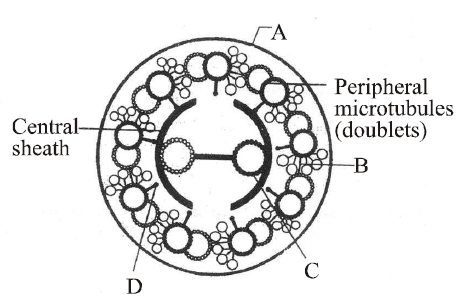
A. A Plasma membrane, B Interdoublet bridge, C Central microtubule, D Radial spoke
B. A Plasma membrane, B Arm, C Central microtubule, D Radial spoke
C. A Plasma membrane, B Interdoublet bridge, C Hub, D Radial spoke
D. A Plasma membrane, B Interdoublet bridge, C Hub, D Arm
Answer : A

A. A Plasma membrane, B Interdoublet bridge, C Central microtubule, D Radial spoke
B. A Plasma membrane, B Arm, C Central microtubule, D Radial spoke
C. A Plasma membrane, B Interdoublet bridge, C Hub, D Radial spoke
D. A Plasma membrane, B Interdoublet bridge, C Hub, D Arm
Answer : A
13. Prokaryotic and eukaryotic flagella differ in the
A. type of movement and placement.
B. location and mode of functioning.
C. microtubular structure and function.
D. microtubular organization and type of movement.
Answer : D
A. type of movement and placement.
B. location and mode of functioning.
C. microtubular structure and function.
D. microtubular organization and type of movement.
Answer : D
14. Which of the following terms is not correctly matched with its feature?
A. Osmosis Movement of water by diffusion.
B. Nucleoplasm Site of active synthesis of ribosomal RNA.
C. Mesosome Infolding of cell membrane and characteristics of eukaryotes.
D. Pili Elongated tubular surface structures (made of special protein) of bacteria.
Answer : C
A. Osmosis Movement of water by diffusion.
B. Nucleoplasm Site of active synthesis of ribosomal RNA.
C. Mesosome Infolding of cell membrane and characteristics of eukaryotes.
D. Pili Elongated tubular surface structures (made of special protein) of bacteria.
Answer : C
15. Both the membranes of mitochondrion are
A. structurally different but functionally similar.
B. structurally as well as functionally different.
C. structurally similar but functionally different.
D. structurally different but functionally similar.
Answer : B
A. structurally different but functionally similar.
B. structurally as well as functionally different.
C. structurally similar but functionally different.
D. structurally different but functionally similar.
Answer : B
16. Identify the cell organelle given below. Which is an important site of formation of glyeoproteins & glycolipids
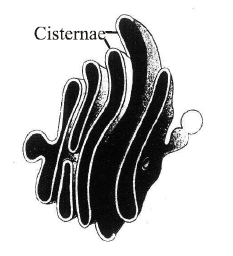
A. Rough endoplasmic reticulum
B. Smooth endoplasmic reticulum
C. Golgi body
D. mitochondria
Answer : C

A. Rough endoplasmic reticulum
B. Smooth endoplasmic reticulum
C. Golgi body
D. mitochondria
Answer : C
17. The given diagram shows the types of chromosomes (labelled as A, B, C & D) based on the position of centromere.
Which one is the correct opton for the labelled chromosomes. A, B, C and D ?

A. A Telocentric chromosome, B Acrocentric chromosome, C Submetacentric chromosome, D Metacentric chromosome
B. A Acrocentric chromosome, B Telocentric chromosome, C Metacentric chromosome, D Submetacentric chromosome
C. A Submetacentric chromosome, B Metacentric chromosome, C Telocentric chromosome, D Acrocentric chromosome
D. A Metacentric chromosome, B Submetacentric chromosome, C Acrocentric chromosome, D Telocentric chromosome.
Answer : A
Which one is the correct opton for the labelled chromosomes. A, B, C and D ?

A. A Telocentric chromosome, B Acrocentric chromosome, C Submetacentric chromosome, D Metacentric chromosome
B. A Acrocentric chromosome, B Telocentric chromosome, C Metacentric chromosome, D Submetacentric chromosome
C. A Submetacentric chromosome, B Metacentric chromosome, C Telocentric chromosome, D Acrocentric chromosome
D. A Metacentric chromosome, B Submetacentric chromosome, C Acrocentric chromosome, D Telocentric chromosome.
Answer : A
18. Read the statements given below with regard to the functions performed by Golgi apparatus ?
Which of the following is the correct answer ?
A. (i) is wrong but (ii) and (iii) are correct
B. (ii) is wrong but (i) and (iii) are correct
C. (ii) and (iii) are wrong but (i) is correct
D. All are correct.
Answer : D
- Transport and chemically modify the materials contained within it.
- Performs the function of packaging materials.
- Important site of formation of glycoproteins and glycolipids.
Which of the following is the correct answer ?
A. (i) is wrong but (ii) and (iii) are correct
B. (ii) is wrong but (i) and (iii) are correct
C. (ii) and (iii) are wrong but (i) is correct
D. All are correct.
Answer : D
19. Which of the following is incorrect ?
A. Mycoplasma is the smallest cell (0.3 �).
B. Bacteria are 3 to 5 �m in size.
C. The largest cell is the egg of an ostrich.
D. Nerve cells are some of the smallest cells.
Answer : D
A. Mycoplasma is the smallest cell (0.3 �).
B. Bacteria are 3 to 5 �m in size.
C. The largest cell is the egg of an ostrich.
D. Nerve cells are some of the smallest cells.
Answer : D
20. Nucleolus is
A. rounded structure found in cytoplasm near nucleus.
B. rounded structure inside nucleus and having rRNA.
C. rod-shaped structure in cytoplasm near the nucleus.
D. none of the above.
Answer : B
A. rounded structure found in cytoplasm near nucleus.
B. rounded structure inside nucleus and having rRNA.
C. rod-shaped structure in cytoplasm near the nucleus.
D. none of the above.
Answer : B
21. Golgi apparatus is absent in
A. higher plants
B. yeast
C. bacteria and blue-green algae
D. None of the above
Answer : C
A. higher plants
B. yeast
C. bacteria and blue-green algae
D. None of the above
Answer : C
22. Centrifugation of a cell results in the rupture of the cell membrane and the contents compacting into a pellets in the bottom of the centrifuge tube. Bathing this pellet with a glucose solution yields metabolic activity including the production of ATP. One of the contents of this pellet is most likely which of the following?
A. Cytosol
B. Mitochondria
C. Lysosomes
D. Golgi bodies
Answer : B
A. Cytosol
B. Mitochondria
C. Lysosomes
D. Golgi bodies
Answer : B
23. The following diagram shows some of the missing structures in a plant cell marked as A, B, C, D E. Choose the option with their correct names.
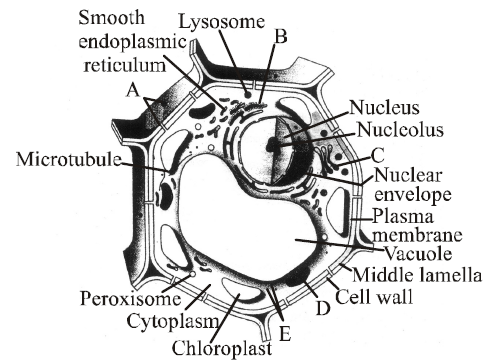
A. A - Plasmodesmata, B - Rough endoplasmic reticulum, C - Golgi apparatus, D - Mitochondrion, E - Ribosomes
B. A - Desmosome, B - Rough endoplasmic reticulum, C - Golgi apparatus, D - Mitochondrion, E - Ribosomes
C. A - Plasmodesmata, B - Smooth endoplasmic reticulum, C - Golgi apparatus, D - Mitochondrion, E - Ribosomes
D. A - Tight junction, B - Rough endoplasmic reticulum, C - Golgi apparatus, D - Mitochondrion, E -Ribosomes
Answer : A

A. A - Plasmodesmata, B - Rough endoplasmic reticulum, C - Golgi apparatus, D - Mitochondrion, E - Ribosomes
B. A - Desmosome, B - Rough endoplasmic reticulum, C - Golgi apparatus, D - Mitochondrion, E - Ribosomes
C. A - Plasmodesmata, B - Smooth endoplasmic reticulum, C - Golgi apparatus, D - Mitochondrion, E - Ribosomes
D. A - Tight junction, B - Rough endoplasmic reticulum, C - Golgi apparatus, D - Mitochondrion, E -Ribosomes
Answer : A
24. Chromosomes having equal or almost equal arms are called
A. metacentric
B. acrocentric
C. polycentric
D. acentric.
Answer : A
A. metacentric
B. acrocentric
C. polycentric
D. acentric.
Answer : A
25. In which method of transport, plasma membrane does not require carrier molecule?
A. Active transport
B. Facilitated diffusion
C. Simple diffusion
D. Na+ K+ pump
Answer : C
A. Active transport
B. Facilitated diffusion
C. Simple diffusion
D. Na+ K+ pump
Answer : C
26. According to widely accepted fluid mosaic model cell membranes are semi-fluid, where lipids and integral proteins can diffuse randomly. In recent years, this model has been modified in several respects. In this regard, which of the following statements is incorrect?
A. Proteins in cell membranes can travel within the lipid bilayer.
B. Proteins can also undergo flip-flop movements in the lipid bilayer.
C. Proteins can remain confined within certain domains of the membrane.
D. Many proteins remain completely embedded within the lipid bilayer.
Answer : B
A. Proteins in cell membranes can travel within the lipid bilayer.
B. Proteins can also undergo flip-flop movements in the lipid bilayer.
C. Proteins can remain confined within certain domains of the membrane.
D. Many proteins remain completely embedded within the lipid bilayer.
Answer : B
27. The best material for study of structure of cell membrane is
A. RBC of human
B. RBC of frog
C. cheek cell of human
D. liver cell of rat
Answer : A
A. RBC of human
B. RBC of frog
C. cheek cell of human
D. liver cell of rat
Answer : A
28. Which one of the following organelle given below is correctly matched with its function ?
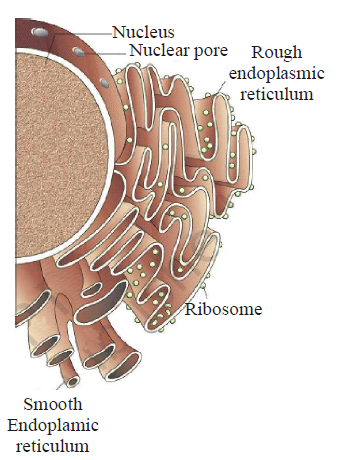
A. Golgi apparatus Protein synthesis
B. Golgi apparatus Formation of glycolipids
C. Rough endoplasmic reticulum Protein synthesis
D. Rough endoplasmic reticulum Formation of glycoproteins
Answer : C

A. Golgi apparatus Protein synthesis
B. Golgi apparatus Formation of glycolipids
C. Rough endoplasmic reticulum Protein synthesis
D. Rough endoplasmic reticulum Formation of glycoproteins
Answer : C
29. What would happen if lysosomes get ruptured in a cell?
A. Cell dies
B. Cell shrinks
C. Cell swell up
D. Nothing would happen
Answer : A
A. Cell dies
B. Cell shrinks
C. Cell swell up
D. Nothing would happen
Answer : A
30. Integral proteins of cell membrane occur on/in
A. inner surfaces
B. outer surfaces
C. phospholipid matrix
D. inner and outer surfaces
Answer : D
A. inner surfaces
B. outer surfaces
C. phospholipid matrix
D. inner and outer surfaces
Answer : D
31. Extension of plasma membrane in prokaryotic cell is
A. mesosome
B. haploid
C. ribosome
D. none of these
Answer : A
A. mesosome
B. haploid
C. ribosome
D. none of these
Answer : A
32. Match column-I with column-II and choose the correct option.
A. A III; B IV; C II; D I
B. A IV; B III; C II; D I
C. A I; B II; C III; D IV
D. A IV; B III; C I ; D II
Answer : A
| Column-I | Column-II |
|---|---|
| (Chromosome) | (Position of Centromere) |
| A. Metacentric | I. At the tip |
| B. Submetacentric | II. Almost near the tip |
| C. Acrocentric | III. At the middle |
| D. Telocentric | IV. Slightly away from the middle |
A. A III; B IV; C II; D I
B. A IV; B III; C II; D I
C. A I; B II; C III; D IV
D. A IV; B III; C I ; D II
Answer : A
33. Plastids storing fat are called
A. Elaioplasts
B. Sphaerosomes
C. Aleuroplasts
D. Pyrenoids
Answer : A
A. Elaioplasts
B. Sphaerosomes
C. Aleuroplasts
D. Pyrenoids
Answer : A
34. Match column-I (scientists) with column-II (discovery) and select the correct option.
A. A I, B III, C IV, D II
B. A I, B III, C II, D IV
C. A III, B I, C IV, D II
D. A I, B IV, C II, D III
Answer : A
| Column-I | Column-II |
|---|---|
| A. Leeuwenhoek | I. First saw and described a living cell |
| B. Robert Brown | II. Presence of cell wall is unique to plant cells |
| C. Schleiden | III. Discovered the nucleus |
| D. Schwann | IV. All plants are composed of different kind of cells |
A. A I, B III, C IV, D II
B. A I, B III, C II, D IV
C. A III, B I, C IV, D II
D. A I, B IV, C II, D III
Answer : A
35. Function of RER is
A. autolysis
B. protein synthesis
C. lipid synthesis
D. carbohydrate synthesis
Answer : B
A. autolysis
B. protein synthesis
C. lipid synthesis
D. carbohydrate synthesis
Answer : B
36. Which of the following lacks cell wall?
A. Gametes
B. Amoeba
C. Mycoplasma
D. All of these
Answer : D
A. Gametes
B. Amoeba
C. Mycoplasma
D. All of these
Answer : D
37. The membrane of the erythrocytes has approximately ___% of proteins and ___% lipids.
A. 42, 50
B. 52, 40
C. 50, 50
D. 60, 40
Answer : B
A. 42, 50
B. 52, 40
C. 50, 50
D. 60, 40
Answer : B
38. Consider the following statements and choose the correct statement.
A. (i) and (iii)
B. (ii) and (iv)
C. (iii) and (iv)
D. (ii) and (iii)
Answer : D
- The endomembrane system includes mitochondria, chloroplast and peroxisomes.
- Smooth endoplasmic reticulum is the major site for synthesis of lipid.
- Rough endoplasmic reticulum is actively involved in protein synthesis.
- Mitochondrial matrix possesses single circular DNA, a few RNA and 80S ribosomes. Of the above statements.
A. (i) and (iii)
B. (ii) and (iv)
C. (iii) and (iv)
D. (ii) and (iii)
Answer : D
39. An organalle devoid of membrane covering is
A. vacuole
B. ribosome
C. peroxisome
D. lysosome
Answer : B
A. vacuole
B. ribosome
C. peroxisome
D. lysosome
Answer : B
40. The diagram given below represent a filuid mosaic model of plasma membrance. Match the components marked as A, B, C, D and E in the diagram below from the list (i) to (vii).
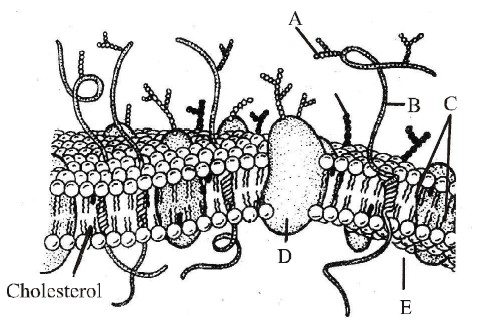
A. A - (i), B - (ii), C - (iii), D - (iv), E - (v)
B. A - (ii), B - (i), C - (iii), D - (iv), E - (v)
C. A - (i), B - (ii), C - (iii), D - (iv), E - (vi)
D. A - (i), B - (ii), C - (iii), D - (vii), E - (v)
Answer : A

- Sugar
- Protein
- Lipid bilayer
- Integral protein
- Cytoplasm
- Cell wall
- External protein
A. A - (i), B - (ii), C - (iii), D - (iv), E - (v)
B. A - (ii), B - (i), C - (iii), D - (iv), E - (v)
C. A - (i), B - (ii), C - (iii), D - (iv), E - (vi)
D. A - (i), B - (ii), C - (iii), D - (vii), E - (v)
Answer : A
41. The main organelle involved in modification and routing of newly synthesized proteins to their destinations is
A. chloroplast
B. mitochondria
C. lysosome
D. endoplasmic reticulum
Answer : D
A. chloroplast
B. mitochondria
C. lysosome
D. endoplasmic reticulum
Answer : D
42. Function of contractile vacuole in Amoeba is
A. excretion and osmoregulation.
B. digestion and respiration.
C. osmoregulation and transportation.
D. none of the above.
Answer : A
A. excretion and osmoregulation.
B. digestion and respiration.
C. osmoregulation and transportation.
D. none of the above.
Answer : A
43. Which of the following statement is correct regarding vacuole?
A. It is membrane-bound and contains storage proteins and lipids.
B. It is membrane-bound and contains water and excretory substances.
C. It lacks membrane and contains air.
D. It lacks membrane and contains water and excretory substances.
Answer : B
A. It is membrane-bound and contains storage proteins and lipids.
B. It is membrane-bound and contains water and excretory substances.
C. It lacks membrane and contains air.
D. It lacks membrane and contains water and excretory substances.
Answer : B
44. Given below are some characters of a cell organelle identify the correct organelle which shows all the characters described above.
A. Golgi apparatus
B. Lysosomes
C. Endoplasmic reticulum
D. Vacuoles
Answer : D
- It is a membrane bound space found in the cytoplasm.
- It is bound by a single membrane called tonoplast.
- It contains water, sap, excretory products and other materials not useful to the cell.
- It has higher concentration of sap than the cytoplasm.
A. Golgi apparatus
B. Lysosomes
C. Endoplasmic reticulum
D. Vacuoles
Answer : D
45. The fluidity of membranes in a plant in cold weather may be maintained by
A. increasing the number of phospholipids with unsaturated hydrocarbon tails.
B. increasing the proportion of integral proteins.
C. increasing concentration of cholesterol in membrane.
D. increasing the number of phospholipids with saturated hydrocarbon tail.
Answer : A
A. increasing the number of phospholipids with unsaturated hydrocarbon tails.
B. increasing the proportion of integral proteins.
C. increasing concentration of cholesterol in membrane.
D. increasing the number of phospholipids with saturated hydrocarbon tail.
Answer : A
46. Cell sap is a
A. living content of cytoplasm.
B. nonliving content of cytoplasm.
C. nonliving content of vacuole.
D. living content of vacuole.
Answer : C
A. living content of cytoplasm.
B. nonliving content of cytoplasm.
C. nonliving content of vacuole.
D. living content of vacuole.
Answer : C
47. Which of the following option correctly match A, B, C, and D indicated in the given sectional view of chloroplasts.

A. A - Thylakoid, B-Stromal lamella, C - Stroma, D - Granum
B. A - Granum, B - Thylakoid, C - Stromal lamella, D - Stroma
C. A - Thylakoid, B - Granum, C - Stromal lamella, D - Stroma
D. A - Granum, B - Thylakoid, C - Stroma, D - Stromal lamella
Answer : B

A. A - Thylakoid, B-Stromal lamella, C - Stroma, D - Granum
B. A - Granum, B - Thylakoid, C - Stromal lamella, D - Stroma
C. A - Thylakoid, B - Granum, C - Stromal lamella, D - Stroma
D. A - Granum, B - Thylakoid, C - Stroma, D - Stromal lamella
Answer : B
48. Which of the following statements are correct ?
A. (iii) and (iv)
B. (i) and (ii)
C. (ii) and (iii)
D. (i) and (iv)
Answer : A
- In prokaryotic cells, a special membranous structure formed by the extension of the plasma membrane into the cell is known as polysome.
- The smooth endoplasmic reticulum is the major site for synthesis of glycoproteins.
- RuBisCO is the most abundant protein in the whole biosphere.
- Mitochondria, chloroplasts and peroxisomes are not considered as part of endomembrane system. Of the above statements
A. (iii) and (iv)
B. (i) and (ii)
C. (ii) and (iii)
D. (i) and (iv)
Answer : A
49. Microtubules are absent in
A. mitochondria
B. centriole
C. flagella
D. spindle fibres
Answer : A
A. mitochondria
B. centriole
C. flagella
D. spindle fibres
Answer : A
50. Lysosomes contain
A. carbohydrates
B. hormones
C. nucleic acids
D. hydrolases.
Answer : D
A. carbohydrates
B. hormones
C. nucleic acids
D. hydrolases.
Answer : D
Sharing is caring
Related Post
Applied Mechanics and Graphic Statics MCQ Solved Paper for RBI Assistant
ISRO Recruitment - Java Programming 1000+ MCQ [Solved] PDF Download
Morphology of flowering plants MCQ Solved Paper for NEET PG
Adobe Flash 1000+ MCQ with answer for RRB ALP
1000+ Power Plant Engineering MCQ for ESIC [Solved]
Building Materials 1000+ MCQ with answer for CEED